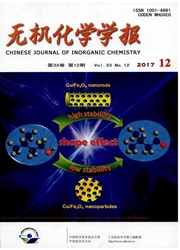

 中文摘要:
中文摘要:
本文通过阳极氧化法直接在铜片上生长出纳米氧化亚铜阵列,所得到的样品通过扫描电子显微镜(SEM),紫外可见漫反射(UV-Vis diffuser reflectance),X-射线光电子能谱(XPS)等方法进行了表征,并研究了不同形貌氧化亚铜的杀菌效果。实验结果表明:反应过程中在阳极液中加入一定量的CTAB,有助于氧化亚铜的定向生长。通过控制反应条件(如电流密度,温度,和反应时间),可以得到不同形貌的氧化亚铜。随着电流密度的增大,氧化亚铜的形貌从网状,片状到棒状进行转化。所得到氧化亚铜的禁带宽度为1.95 eV。用所得样品进行杀菌实验,1 h内棒状氧化亚铜的杀菌率达到90.85%,而其它形貌的氧化亚铜杀菌率只有50%左右,与空铜片的杀菌率30%相比,所制得氧化亚铜具有较好的杀菌效果。
 英文摘要:
英文摘要:
Cuprous oxide nanostructures were prepared by the method of copper anode oxidation. The obtained cuprous oxide was characterized with the techques of scanning electron microscopy, UV-Vis diffuse reflectance and X-ray photoelectron spectroscopy. The sterilization property of the samples was also investigated. It is found that CTAB plays an important role in the directional growth of the cuprous oxide. By controlling the reaction condition, such as current density, temperature and the reaction time, we can get different morphologies of Cu2O. With the increase of current density, the morphology of Cu2O can be nanonet, nanosheet and nanorod arrays respectively. In addition, the nanorod cuprous oxide has the best activity in sterilization and the sterilization efficiency can reach 90.85% in an hour.
 同期刊论文项目
同期刊论文项目
 同项目期刊论文
同项目期刊论文
 Electrochemistry and electrocatalysis of myoglobin on carbon coated Fe3O4 nanospindle modified carbo
Electrochemistry and electrocatalysis of myoglobin on carbon coated Fe3O4 nanospindle modified carbo A simple approach for the synthesis of Cu2O films with periodic morphology transformation onto diffe
A simple approach for the synthesis of Cu2O films with periodic morphology transformation onto diffe Nitrogen-doped TiO2 nanoparticles by using EDTA as nitrogen source and soft template: Simple prepara
Nitrogen-doped TiO2 nanoparticles by using EDTA as nitrogen source and soft template: Simple prepara CuBi2O4 single crystal nanorods prepared by hydrothermal method: Growth mechanism and optical proper
CuBi2O4 single crystal nanorods prepared by hydrothermal method: Growth mechanism and optical proper P-type and n-type Cu2O semiconductor thin films: controllable preparation by simple solvothermal met
P-type and n-type Cu2O semiconductor thin films: controllable preparation by simple solvothermal met Cu2O nanorod thin films prepared by CBD method with CTAB: substrate effect, deposition mechanism and
Cu2O nanorod thin films prepared by CBD method with CTAB: substrate effect, deposition mechanism and Synthesis of (CuIn)xCd2(1-x)S2 photocatalysts for H2 evolution under visible light by using a low-te
Synthesis of (CuIn)xCd2(1-x)S2 photocatalysts for H2 evolution under visible light by using a low-te Bifunctional photocatalysis of TiO2 /Cu2O composite under visible light: Ti3+ in organic pollutant d
Bifunctional photocatalysis of TiO2 /Cu2O composite under visible light: Ti3+ in organic pollutant d Self-assembled Cu2O flowerlike architecture: Polyol synthesis, photocatalytic activity and stability
Self-assembled Cu2O flowerlike architecture: Polyol synthesis, photocatalytic activity and stability Visible-Light-Driven Photocatalytic Inactivation of E. coli K-12 by Bismuth Vanadate Nanotubes: Bact
Visible-Light-Driven Photocatalytic Inactivation of E. coli K-12 by Bismuth Vanadate Nanotubes: Bact 期刊信息
期刊信息
